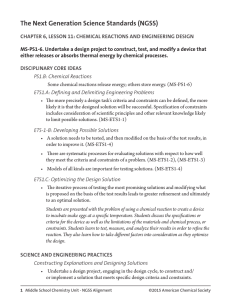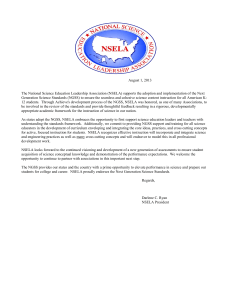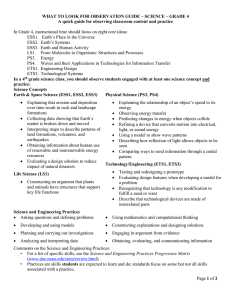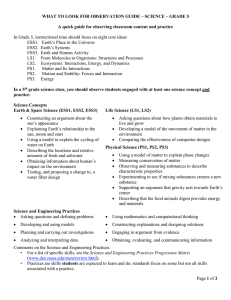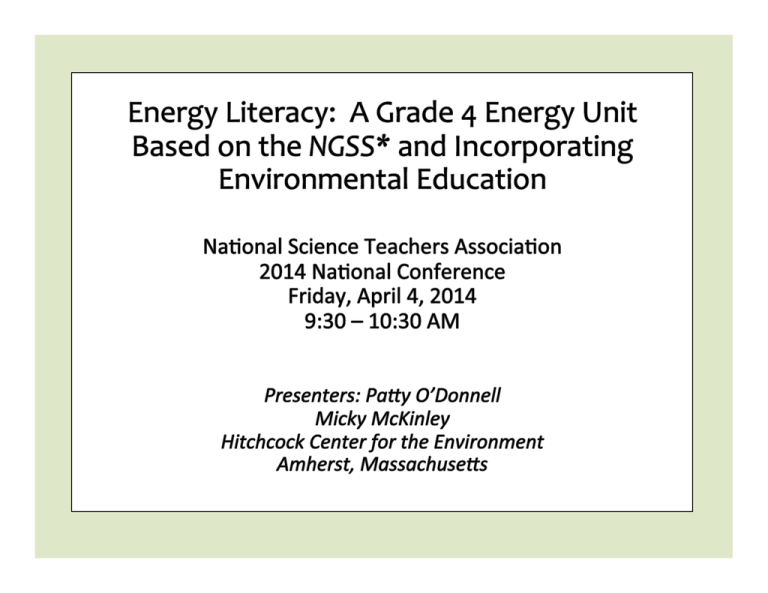
Workshop Agenda: • Who we are • Background on development of our Energy Literacy unit • NEEEA/U.S. EPA Sub-­‐grant • NGSS alignment • Design of Unit • DemonstraGon of Materials • Hands-­‐on Renewable Energy invesGgaGons • How to access curriculum unit Education for a Healthy Planet About Us The Hitchcock Center for the Environment is an independent nonprofit organization whose mission is to foster a greater awareness and understanding of our environment and to develop environmentally literate citizens. Energy Is Electrifying! Curriculum is available for FREE download from the Hitchcock Center website: (see resources dropdown menu) Contact Information: 525 South Pleasant Street Amherst, MA 01002 (413) 256-­‐6006 / (413) 253-­‐2809 fax hOp://www.hitchcockcenter.org Hitchcock Center Grant: Integra)ng Environmental Literacy and the Next Genera)on Science Standards* •
Funded by the New England Environmental EducaGon Alliance (NEEEA) and the U.S. EPA Environmental EducaGon Sub-­‐Grants program. • Why we did this – we were inspired by the environmental themes elucidated in the NaGonal Research Council (NRC) document – A Framework for K–12 Science Educa)on: Prac)ces, CrosscuHng Concepts, and Core Ideas – which guided the development of the NGSS. • Provided an opportunity to demonstrate how environmental educaGon can be used as an organizing principal to teach science concepts. • We developed three environmental focused curriculum units for grades 3-­‐5, aligned with the NGSS: -­‐ 3rd Grade -­‐ The Pond Ecosystem -­‐ 4th Grade -­‐ Energy Is Electrifying! -­‐ 5th Grade – The Hydrosphere, Water and How We Use It *Next GeneraGon Science Standards is a registered trademark of Achieve. Neither Achieve nor the lead states and partners that developed the Next GeneraGon Science Standards was involved in the producGon of, and does not endorse, this product. History of Hitchcock Centers Energy Literacy Programs • We have had an ongoing commitment to Energy Literacy EducaGon • We provide Professional Development for Teachers of Grades 4, 5 & 6 • We model the curriculum in classrooms • The NEEEA grant enable us to expand on this curriculum, incorporate the Next GeneraGon Science Standards*, and make it available to a broader audience Next GeneraGon Science Standards* • Based on the Framework for K–12 Science Educa)on, released by the NaGonal Research Council (NRC) of the NaGonal Academy of Sciences, in July 2011 • Developed by (NRC), NaGonal Science Teachers AssociaGon, American AssociaGon for the Advancement of Science, and Achieve, a biparGsan, non-­‐
profit, educaGon reform organizaGon; with writers from 26 lead states • NGSS released for adopGon in April 2013 • Currently adopted by 11 states: California, Delaware, the District of Columbia, Illinois, Kansas, Kentucky, Maryland, Nevada, Rhode Island, Vermont, and Washington. • Web address: hOp://www.nextgenscience.org MassachuseOs and the NGSS • The MA Drad Revised Science and Technology/Engineering (STE) Standards, released December 2013, are based on the NGSS but are an adaptaGon of NGSS. • Expected to move forward for adopGon in the 2015-­‐2016 school year • For more informaGon, refer to the MassachuseOs Department of Elementary and Secondary EducaGon website: www.doe.mass.edu/STEM/review.html Overview of NGSS Format • The Standards, by Grade Level and Discipline • Performance Expecta)ons – What is Assessed • FoundaGon Boxes: Ø Science and Engineering Prac)ces – How we teach, for example designing invesGgaGons and using models Ø Disciplinary Core Ideas – What we teach; the content §
§
§
§
Physical Sciences (PS) Life Sciences (LS) Earth and Space Sciences (ESS) Engineering, Technology and ApplicaGons of Science (ETS) Ø Cross-­‐cuHng Concepts – The Interdisciplinary Nature of Science, for example PaOerns, Systems, Energy Flows and Cycles • ConnecGons to Common Core State Standards NGSS* LAYOUT Grade Level and Title Decoding the NGSS* *Next GeneraGon Science Standards is a registered trademark of Achieve. Neither Achieve nor the lead states and partners that developed the Next GeneraGon Science Standards was involved in the producGon of, and does not endorse, this product. 4.Energy
Example: Physical Science (PS) Standard -­‐ ENERGY – Grade 4 4.Energy
Students who demonstrate understanding can:
4-PS3-1. Use evidence to construct an explanation relating the speed of an object to the energy of that object.
[Assessment
Boundary: Assessment does not include quantitative measures of changes in the speed of an object or on any precise or quantitative definition of energy.]
4-PS3-2.
Make observations to provide evidence that energy can be transferred from place to place by sound, light, heat, and
electric currents. [Assessment Boundary: Assessment does not include quantitative measurements of energy.]
Ask questions and predict outcomes about the changes in energy that occur when objects collide. [Clarification Statement:
4-PS3-3.
Emphasis is on the change in the energy due to the change in speed, not on the forces, as objects interact.] [Assessment Boundary: Assessment does not include
quantitative measurements of energy.]
Apply scientific ideas to design, test, and refine a device that converts energy from one form to another.* [Clarification
Statement: Examples of devices could include electric circuits that convert electrical energy into motion energy of a vehicle, light, or sound; and, a passive solar heater
that converts light into heat. Examples of constraints could include the materials, cost, or time to design the device.] [Assessment Boundary: Devices should be limited
to those that convert motion energy to electric energy or use stored energy to cause motion or produce light or sound.]
4-PS3-4.
4-ESS3-1. Obtain and combine information to describe that energy and fuels are derived from natural resources and their uses
affect the environment. [Clarification Statement: Examples of renewable energy resources could include wind energy, water behind dams, and sunlight; nonrenewable energy resources are fossil fuels and fissile materials. Examples of environmental effects could include loss of habitat due to dams, loss of habitat due to
surface mining, and air pollution from burning of fossil fuels.]
The performance expectations above were developed using the following elements from the NRC document A Framework for K-12 Science Education:
Science and Engineering Practices
Disciplinary Core Ideas
Crosscutting Concepts
Asking Questions and Defining Problems
Asking questions and defining problems in grades 3–5
builds on grades K–2 experiences and progresses to
specifying qualitative relationships.
Ask questions that can be investigated and predict
reasonable outcomes based on patterns such as cause
and effect relationships. (4-PS3-3)
Planning and Carrying Out Investigations
Planning and carrying out investigations to answer
questions or test solutions to problems in 3–5 builds on K–
2 experiences and progresses to include investigations that
control variables and provide evidence to support
explanations or design solutions.
Make observations to produce data to serve as the
basis for evidence for an explanation of a
phenomenon or test a design solution. (4-PS3-2)
Constructing Explanations and Designing Solutions
Constructing explanations and designing solutions in 3–5
builds on K–2 experiences and progresses to the use of
evidence in constructing explanations that specify
variables that describe and predict phenomena and in
designing multiple solutions to design problems.
Use evidence (e.g., measurements, observations,
patterns) to construct an explanation. (4-PS3-1)
Apply scientific ideas to solve design problems. (4PS3-4)
Obtaining, Evaluating, and Communicating
Information
Obtaining, evaluating, and communicating information in
3–5 builds on K–2 experiences and progresses to evaluate
the merit and accuracy of ideas and methods.
Obtain and combine information from books and other
reliable media to explain phenomena. (4-ESS3-1)
PS3.A: Definitions of Energy
The faster a given object is moving, the more energy it possesses. (4PS3-1)
Energy can be moved from place to place by moving objects or
through sound, light, or electric currents. (4-PS3-2),(4-PS3-3)
PS3.B: Conservation of Energy and Energy Transfer
Energy is present whenever there are moving objects, sound, light, or
heat. When objects collide, energy can be transferred from one object
to another, thereby changing their motion. In such collisions, some
energy is typically also transferred to the surrounding air; as a result,
the air gets heated and sound is produced. (4-PS3-2),(4-PS3-3)
Light also transfers energy from place to place. (4-PS3-2)
Energy can also be transferred from place to place by electric currents,
which can then be used locally to produce motion, sound, heat, or
light. The currents may have been produced to begin with by
transforming the energy of motion into electrical energy. (4-PS3-2),(4PS3-4)
PS3.C: Relationship Between Energy and Forces
When objects collide, the contact forces transfer energy so as to
change the objects’ motions. (4-PS3-3)
PS3.D: Energy in Chemical Processes and Everyday Life
The expression “produce energy” typically refers to the conversion of stored energy into a desired form for practical use. (4-PS3-4)
ESS3.A: Natural Resources
Energy and fuels that humans use are derived from natural sources,
and their use affects the environment in multiple ways. Some
resources are renewable over time, and others are not. (4-ESS3-1)
ETS1.A: Defining Engineering Problems
Possible solutions to a problem are limited by available materials and
resources (constraints). The success of a designed solution is
determined by considering the desired features of a solution (criteria).
Different proposals for solutions can be compared on the basis of how
well each one meets the specified criteria for success or how well each
takes the constraints into account. (secondary to 4-PS3-4)
Cause and Effect
Cause and effect relationships are
routinely identified and used to explain
change. (4-ESS3-1)
Energy and Matter
Energy can be transferred in various
ways and between objects. (4-PS3-1), (4PS3-2),(4-PS3-3),(4-PS3-4)
---------------------------------------------
Connections to Engineering, Technology,
and Applications of Science
Interdependence of Science,
Engineering, and Technology
Knowledge of relevant scientific concepts
and research findings is important in
engineering. (4-ESS3-1)
Influence of Engineering, Technology,
and Science on Society and the Natural
World
Over time, people’s needs and wants change, as do their demands for new and
improved technologies. (4-ESS3-1)
Engineers improve existing technologies
or develop new ones. (4-PS3-4)
----------------------------------------------
Connections to Nature of Science
Science is a Human Endeavor
Most scientists and engineers work in
teams. (4-PS3-4)
Science affects everyday life. (4-PS3-4)
Connections to other DCIs in fourth grade: N/A
Articulation of DCIs across grade-levels: K.PS2.B (4-PS3-3); K.ETS1.A (4-PS3-4); 2.ETS1.B (4-PS3-4); 3.PS2.A (4-PS3-3); 5.PS3.D (4-PS3-4); 5.LS1.C (4-PS3-4); 5.ESS3.C (4-ESS31); MS.PS2.A (4-PS3-3); MS.PS2.B (4-PS3-2); MS.PS3.A (4-PS3-1),(4-PS3-2),(4-PS3-3),(4-PS3-4); MS.PS3.B (4-PS3-2),(4-PS3-3),(4-PS3-4); MS.PS3.C (4-PS3-3); MS.PS3.D (4ESS3-1); MS.PS4.B (4-PS3-2); MS.ESS2.A (4-ESS3-1); MS.ESS3.A (4-ESS3-1); MS.ESS3.C (4-ESS3-1); MS.ESS3.D (4-ESS3-1); MS.ETS1.B (4-PS3-4); MS.ETS1.C (4-PS3-4)
Common Core State Standards Connections:
ELA/Literacy –
RI.4.1
RI.4.3
RI.4.9
W.4.2
W.4.7
W.4.8
W.4.9
Mathematics –
MP.2
MP.4
4.OA.A.1
4.OA.A.3
Refer to details and examples in a text when explaining what the text says explicitly and when drawing inferences from the text. (4-PS3-1)
Explain events, procedures, ideas, or concepts in a historical, scientific, or technical text, including what happened and why, based on specific information in the text. (4-PS3-1)
Integrate information from two texts on the same topic in order to write or speak about the subject knowledgeably. (4-PS3-1)
Write informative/explanatory texts to examine a topic and convey ideas and information clearly. (4-PS3-1)
Conduct short research projects that build knowledge through investigation of different aspects of a topic. (4-PS3-2),(4-PS3-3),(4-PS3-4),(4-ESS3-1)
Recall relevant information from experiences or gather relevant information from print and digital sources; take notes and categorize information, and provide a list of
sources. (4-PS3-1),(4-PS3-2),(4-PS3-3),(4-PS3-4),(4-ESS3-1)
Draw evidence from literary or informational texts to support analysis, reflection, and research. (4-PS3-1),(4-ESS3-1)
Reason abstractly and quantitatively. (4-ESS3-1)
Model with mathematics. (4-ESS3-1)
Interpret a multiplication equation as a comparison, e.g., interpret 35 = 5 × 7 as a statement that 35 is 5 times as many as 7 and 7 times as many as 5. Represent verbal
statements of multiplicative comparisons as multiplication equations. (4-ESS3-1)
Solve multistep word problems posed with whole numbers and having whole-number answers using the four operations, including problems in which remainders must be
interpreted. Represent these problems using equations with a letter standing for the unknown quantity. Assess the reasonableness of answers using mental computation
and estimation strategies including rounding. (4-PS3-4)
*The performance expectations marked with an asterisk integrate traditional science content with engineering through a Practice or Disciplinary Core Idea.
The section entitled “Disciplinary Core Ideas” is reproduced verbatim from A Framework for K-12 Science Education: Practices, Cross-Cutting Concepts, and Core Ideas. Integrated
and reprinted with permission from the National Academy of Sciences.
May 2013
©2013 Achieve, Inc. All rights reserved.
1 of 1
Energy Is Electrifying! Unit Format • NGSS* Alignment is indicated at the beginning of the unit, and referenced in each Daily Plan • Conceptual Flow for Student Understanding – Ø
Ø
Ø
Ø
Ø
Background on Energy, Electricity and Electro-­‐magnets Forms of Energy Fossil Fuel Energy Sources Electrical GeneraGon Renewable Energy Sources • Focus on Design InvesGgaGons (Correlate with NGSS ETS standards, Grade3-­‐5) Ø Model Electro-­‐magnet generators Ø Renewable Energy InvesGgaGons -­‐ Wind and Solar • AddiGonal Hands-­‐On AcGviGes in Unit: Ø Light Bulb Comparisons Ø Appliance Efficiency Comparisons • Student Energy Chain Drawings – Illustrate their conceptual understanding of Energy Flow from the Sun, to the lights in the classroom Unit Resources •
Book My Light, by Molly Bang •
Northeast Sustainable Energy AssociaGon (NESEA). Available through the following website: hOp://energyteachers.org/project_detail.php?project_id=13 •
•
•
NaGonal Energy EducaGon Development Project (NEED) hOp://www.need.org NOVA Labs -­‐ PBS Learning Media – WGBH Boston
hOp://www.pbs.org/wgbh/nova/labs/videos/ SWITCH ENERGY PROJECT hOp://www.switchenergyproject.com …Plus many more cited in the unit My Light MY LIGHT by Molly Bang We reference My Light by Molly Bang oden in this unit, and include it in our Professional Development bag of materials for teachers. We are inspired by the author’s ability to make a seemingly overwhelming and complex energy concepts accessible. Ms. Bang brilliantly creates connecGons, and interconnecGons, all beginning with the singular source of energy for life on earth – our SUN. Our Energy Is Electrifying! Unit also complements the document published by the U.S. Department of Energy enGtled Energy Literacy: Essen)al Principals and Fundamental Concepts for Energy Educa)on. (Some copies available on hand-­‐outs table, or online at the following website: hOp://library.globalchange.gov/energy-­‐literacy-­‐essenGal-­‐principles-­‐fundamental-­‐concepts-­‐for-­‐
energy-­‐educaGon Energy Systems Thinking Materials Demonstrated at NSTA Workshop • Materials in Professional Development Teacher Kit • Devices for measuring Electric Output Ø MulGmeter Ø Kill-­‐A-­‐WaO Meter • Demo – Hand-­‐made Electromagnet generator • Hands-­‐On StaGons: Ø Wind Energy Ø Solar Energy Student Data Sheet for Renewable Energy StaGons Energy Chain Student Drawings

